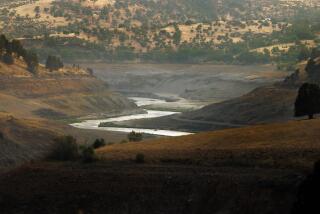Pumping Life Back Into the Grand Canyon
PAGE, Ariz. — As dawn’s light filtered into the sandstone gorge 600 feet below the lip of Glen Canyon Dam, a cannonade of water blasted out across the Colorado River, a cheer went up and the first attempt to rejuvenate the Grand Canyon by flooding it was underway.
U.S. Interior Secretary Bruce Babbitt, who pushed the button that triggered the gusher Tuesday, hailed the occasion as the beginning of “a new era in the way we live on the American landscape.”
It was the first time that the federal government has opened the floodgates on one of its own dams in order to repair some of the damage done to river canyons that have been denied their natural flow for many years.
As the flood tide rolls down through nearly 300 miles of the Grand Canyon National Park over the next week, it will remove debris, unclog back channels that are the historic spawning areas for fish and rebuild other natural habitat. By stirring up sediment from the river bottom, it will also build up the beaches that the canyon’s booming river rafting industry depends on for campsites.
Within an hour after the flood began, the river was beginning to look like its old springtime self. Birds floated by, clinging to piles of driftwood. And as it lapped higher against its rocky skirts, the river started to to take on the reddish brown hue that gave it its Spanish name, Colorado.
Fifteen miles downstream from the dam, where the Grand Canyon officially begins, a flotilla of kayakers and rafters nervously prepared to launch on the rising tide.
“If anyone has any heart medicine, please give half of it to me,” said one of the kayakers as he pulled on his wetsuit. Ahead of the group waited more than 200 miles of surging river and at least 150 rapids.
Nearby, a boatload of National Park Service wildlife biologists began making their way upstream to check on the condition of canyon birds, including wrens, sparrows and woodpeckers, that make nests in low-lying vegetation, some of which will be vulnerable to the rising waters. About 150 scientists from universities and government agencies will be studying the weeklong flood, which took the better part of a decade to plan and approve.
Yet, even as they cheered, some of the experts present were skeptical about the ultimate impact of what mounted to a bureaucratic compromise--a flood that some scientists believe is too small, too short and taking place too early in the year.
“This is a pretty wimpy flood,” said Jack Schmidt, a geomorphologist at Utah State University. An advisor on the project, Schmidt said he had recommended a flow of close to 60,000 cubic feet per second for two weeks instead of what is taking place--about 45,000 cubic feet per second for one week.
Even so, enough water will be released at a fast enough rate to raise the level of the Colorado as much as 15 feet in places in the canyon. The amount of Lake Powell water to be released from the dam’s huge overflow tubes would supply the needs of Los Angeles for seven months. It will be captured again downstream behind Hoover Dam.
Schmidt and others argued that a more powerful flow would be necessary to rebuild the canyon’s eroding beaches and habitat. However, wildlife biologists worried that a bigger flood would wash away too many vulnerable species.
Schmidt and other experts also believe that the flood should have been staged later in the year after the spring melt. Their concern now is that an unusually large mountain snow pack combined with a warm spring could trigger a second flood that would undo the benefits of the first.
“If that should happen, a lot of what is being deposited in the canyon now could simply be blown away,” said Duncan Patten, an Arizona State University ecologist who has been an advisor to the project.
The man-made flood would have been delayed, said Patten, had biologists not feared that too many birds, including the endangered southwestern willow flycatcher, would be building nests in branches close to the water’s edge.
The informal coalition of government experts, academicians and environmentalists who are behind this ambitious experiment to cleanse and renew the Grand Canyon are hoping the event can become a model for rekindling life in other river canyons where dams have interfered with natural processes.
Since Glen Canyon Dam was completed in 1963 to generate electrical power for six western states, floods have been rare here and the sediments and nutrients that buffered canyon walls and sustained fish have been trapped above the dam in Lake Powell. At the same time, dramatic daily fluctuations in river flow to meet power demands have steadily eroded what was left of canyon beaches and sand bars.
“There was a time when scientists believed that flooding was bad for a a river canyon,” said David Wegner, a scientist with the U.S. Bureau of Reclamation who helped plan the Grand Canyon flood. “But over the years, we have learned that river systems need the kind of periodic disturbance that a flood provides.”
More to Read
Sign up for Essential California
The most important California stories and recommendations in your inbox every morning.
You may occasionally receive promotional content from the Los Angeles Times.










